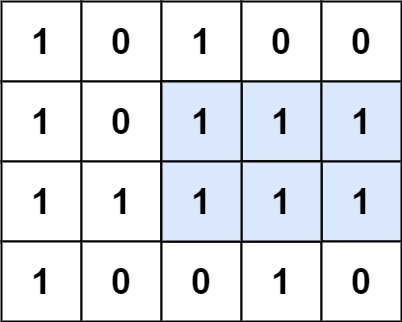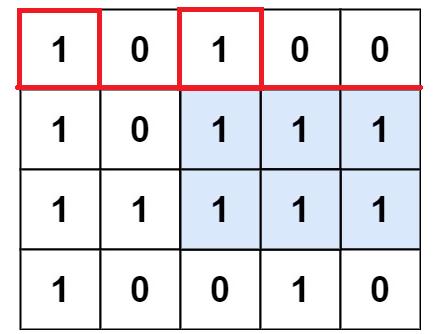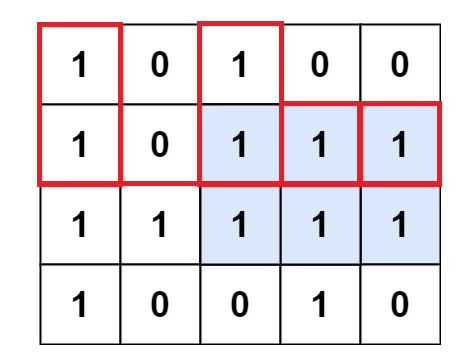单调栈应用——矩形最大面积问题
Posted 白龙码~
tags:
篇首语:本文由小常识网(cha138.com)小编为大家整理,主要介绍了单调栈应用——矩形最大面积问题相关的知识,希望对你有一定的参考价值。
LeetCode 84. 柱状图中最大的矩形
给定 n 个非负整数,用来表示柱状图中各个柱子的高度。每个柱子彼此相邻,且宽度为 1 。
求在该柱状图中,能够勾勒出来的矩形的最大面积。

输入:heights = [2,1,5,6,2,3]
输出:10
解释:最大的矩形为图中红色区域,面积为 10
我们以每个柱子为观测对象:
如果第i根柱子的高度heights[i]是最大矩形的高,矩形的底是[L, R],那么这意味着:heights[L...R]>=heights[i],而heights[L-1]<heights[i], heights[R+1]<heights[i]。

因此,当我们确定某一根柱子为矩形的高时,只需要知道左边第一个矮于它的柱子下标L-1,右边第一个矮于它的柱子下标R+1,那么此时矩形的面积就等于(R-L+1)*heights[i]。
int largestRectangleArea(vector<int>& heights)
int n = heights.size();
stack<int> st;
vector<int> lmin(n); // 左边比heights[i]小的第一个柱子高度
vector<int> rmin(n); // 右边比heights[i]小的第一个柱子高度
for (int i = 0; i < n; ++i)
while (!st.empty() && heights[i] <= heights[st.top()])
st.pop();
lmin[i] = st.empty() ? -1 : st.top();
st.push(i);
st = stack<int>();
for (int i = n - 1; i >= 0; --i)
while (!st.empty() && heights[i] <= heights[st.top()])
st.pop();
rmin[i] = st.empty() ? n : st.top();
st.push(i);
int res = 0;
// L-1=rmin[i],R+1=rmin[i],因此R-L+1=rmin[i] - lmin[i] - 1
for (int i = 0; i < n; ++i)
res = max(res, (rmin[i] - lmin[i] - 1) * heights[i]);
return res;
LeetCode 85. 最大矩形
给定一个仅包含
0和1、大小为rows x cols的二维二进制矩阵,找出只包含1的最大矩形,并返回其面积。

输入:matrix = [["1","0","1","0","0"],["1","0","1","1","1"],["1","1","1","1","1"],["1","0","0","1","0"]]
输出:6
解释:最大矩形如上图所示。
本题等价于上一题,只是我们需要柱状图预处理出来:
如果让第一层作为矩形的底所在层,那么柱状图如红色方框部分所示:

如果让第二层作为矩形的底所在层,那么柱状图如红色方框部分所示:

其它各层同理…如此,本题又被抽象成了LeetCode 84. 柱状图中最大的矩形。
int maximalRectangle(vector<vector<char>>& matrix)
int m = matrix.size();
int n = matrix[0].size();
// count[i][j]表示(i,j)及其上垂直方向有多少个连续1
vector<vector<int>> count(m, vector<int>(n));
for (int i = 0; i < m; ++i)
for (int j = 0; j < n; ++j)
if (i == 0)
count[i][j] = matrix[i][j] == '1';
else
count[i][j] = matrix[i][j] == '1' ? 1 + count[i - 1][j] : 0;
// 遍历第i行,count[i][j]表示当前行第j列的矩形高度
// 我们要求的就是它们形成的矩形的最大面积
int res = 0;
for (int i = 0; i < m; ++i)
stack<int> st;
vector<int> lmin(n); // 左边比count[i][j]小的矩形所在列
vector<int> rmin(n); // 右边比count[i][j]小的矩形所在列
for (int j = 0; j < n; ++j)
while (!st.empty() && count[i][st.top()] >= count[i][j])
st.pop();
lmin[j] = st.empty() ? -1 : st.top();
st.push(j);
st = stack<int>();
for (int j = n - 1; j >= 0; --j)
while (!st.empty() && count[i][st.top()] >= count[i][j])
st.pop();
rmin[j] = st.empty() ? n : st.top();
st.push(j);
// [lmin[j] + 1, rmin[j] - 1]的值都大于等于count[i][j]
// 即count[i][j]在该范围内能够作为矩形的高
for (int j = 0; j < n; ++j)
res = max(res, (rmin[j] - lmin[j] - 1) * count[i][j]);
return res;
以上是关于单调栈应用——矩形最大面积问题的主要内容,如果未能解决你的问题,请参考以下文章